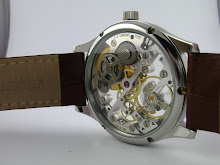We now come to a very delicate and (cosmetically) important part of my watch- the dial. Every stage of making the dial is crucial . One slip-up destroys the whole job and you have to start over. Functionally, the dial must have the correct sized hour & minute markers, the marker track should be centred & it should sit flush on the movement. Aesthetically, the brushed finish & the radius must be carefully applied. Altogether, the dial is a very demanding part.
So, I start with a brass plate 45mm square & about 0.7 to 0.8 mm thick.

As usual, one surface is planed on the glass sheet- central relief for the arbour is drilled- holes for the retaining screws are drilled & the corners are cut off. The plate is mounted with the plane side OUT. Note, this is the under surface of the dial.
Now, the usable area is sandpapered to give it a circular brushed finish & a track is relieved for the 12, 3, 6 & 9 o’clock blued steel markers. This track accommodates the underside of the blued steel markers but it also helps with the overall legibility of the other markers.
Now the job is reversed. This is the top surface that one will see in the watch. First the central area is cut out. Then the central hole is finished to the correct diameter.
Then the usable area is faced & turned down to just over the required thickness. A little is left for the final sandpapering.
Now a printout with 60 radiating lines is stuck on the job. Please note that the job is still mounted on the attachment. The track for the markers is marked on the turns. This ensures that the track is concentric. Below you see the job with the track marked out, removed from the attachment & ready for drilling. In fact you can see that one 0.4 dia. hole has already been drilled. Everything on track so far, but with a dial you can never relax. So, this is where I am today, more in the next post.
Everything on track so far, but with a dial you can never relax. So, this is where I am today, more in the next post.
Aditya









































